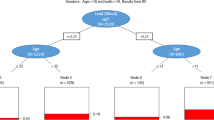Abstract
Design
Cohort study.
Cohort selection
A birth cohort born at the Queen Mary Hospital, Dunedin, New Zealand between 1 April 1972 and 31 March 1973 that are being followed as part of the Dunedin Multidisciplinary Health and Development Study (DMHDS).
Exposure measurement
Periodontal examinations were conducted at ages 26, 32 and 38, with only half-mouth examinations possible at age 26, but full-mouth examinations undertaken at 32 and 38. Third molars and implants were not included in the periodontal examinations. Tobacco smoking was determined at ages 15, 18, 21, 26, 32 and 38.
Outcome measure
Attachment loss (AL).
Data analysis
Generalised linear mixed modelling with a quasi-binomial approach was used to examine associations between chronic smoking and periodontal attachment loss.
Results
Of the 1037 participants initially enrolled in the study, 913 were periodontally examined at age 26, and periodontal data were available for 863 (94.5%) individuals at ages 26, 32, and 38 using listwise deletion. At age 32 and 38 respectively, 918 and 905 (98.6%), and 913 and 869 (95.1%) participants were examined and included in the analysis. Approximately equal numbers of females and males were included. Attachment loss increased in smokers with age. At ages 26, 32 and 38, smokers had 3.5%, 12.8% and 23.2% (respectively) greater AL than non-smokers. Regular cannabis use was associated with greater AL after age 32, but not at age 26. Males had more AL than females. Participants with high plaque scores had consistently greater AL; those who were of persistently low SES (socio-economic status) had higher AL at age 32 and 38, but not at age 26. The amount of AL in anteriors was less than in premolars and molars. Gingival bleeding was associated with higher AL at ages 26, 32 and 38.
Conclusions
This research confirmed the strong association between chronic smoking and periodontal disease.
Similar content being viewed by others
Commentary
Periodontitis is a significant public health issue affecting 45% of dentate adults within the UK.1,2
The authors in this study have a unique opportunity with the Dunedin birth cohort to follow a group of people born in 1973 and observe how lifestyle factors may influence periodontal health. In this paper the authors are interested in how risk factors for periodontal disease (cannabis, smoking and age) influence periodontal attachment loss.
Within the study the outcomes the authors are interested in are gingival recession, probing depth and attachment loss. Most readers would be familiar with the primary variables influencing periodontal health, eg smoking. What are less clear are the secondary variables that can affect the relationship.
It has been demonstratedi that socio-economic classification increases the risk for gingival bleeding so it is useful that information given on socio-economic status was included within the analysis. It is disappointing, but a familiar outcome, that the study was under-represented by groups from areas of deprivation. It may have been beneficial for information to be presented, perhaps as a CONSORT diagram, as to why this element of the cohort was not able to be examined, and at what age this happened.
According to Cochrane3 people who brush and floss regularly have less gum bleeding compared to toothbrushing alone and this paper further supports the relationship between flossing and periodontal health.
It is unsure why the authors, with the richness of information contained within this dataset, only chose to examine specific co-variates. A keen reader would be able to find out that Queen Mary hospital is a state funded hospital, but it is unclear whether the people born are representative of the New Zealand population as a whole. The authors chose not to provide ethnicity as part of the analysis, yet we know from the US National Health and Nutrition Examination Survey, and from a South Pacific perspective4 that there is a relationship between ethnicity and periodontal disease.5
There is growing evidence from a number of papers of the possible relationship between oral health and general health; strong evidence for example that periodontal disease increases risk for cardiovascular disease,6 and weaker evidence of a relationship between periodontal disease and diabetes,7 yet, apart from excluding from the analysis people with rheumatic fever and cardiovascular disease, no other health information is given.
It is unusual that different quadrants were used within the study and then compared. Within the recent adult dental health survey there were clear differences between percentages of sextants with bleeding, with upper left teeth higher than central and right, and lower right and central being higher than lower left.4 The comparison within the Dunedin study of quadrants 1 and 3 with quadrants 2 and 4 therefore could be problematic – but may be overcome with the large sample size within this study.
Cohort studies can be challenging. They rely on the collection of evidence from patients on potential risk factors. Recall bias can occur as patients may be unable to remember their exact habits. Cohort studies inevitably rely on self reporting - and yet for flossing, toothbrushing and smoking8 these practices may be under-reported. To overcome some of these issues the authors could have considered collecting continine levels9 which can approximate actual cigarette usage per day.
Within research of this type calibration is important to ensure examiners are measuring attachment loss in a consistent, similar fashion. The paper does advise that at age 26 the examiners were calibrated; and the authors do present comprehensive information on intra and inter examiner reliability. It is regrettable that time constraints prevented replicate periodontal examinations.
The Cohort study, like all observational studies provides weaker evidence than for example randomised controlled trials, which would in this case have been unethical to carry out.10 Despite these concerns, the authors present additional evidence to suggest that periodontal disease worsens in smokers, with age. Furthermore the results have narrow confidence intervals demonstrating the precision of the results.
References
Disease and related disorders – a report from the Adult Dental Health Survey 2009. Available at: http://www.hscic.gov.uk/catalogue/PUB01086/adul-dent-heal-surv-summ-them-the2-2009-rep4.pdf [Accessed 18th August 2014]
Tonetti MS . Van Dyke TE ; Working group 1 of the joint EFP/AAP workshop. Periodontitis and atherosclerotic cardiovascular disease: consensus report of the Joint EFP/AAP Workshop on Periodontitis and Systemic Diseases. J Clin Periodontol 2013; 40: Suppl 14: S24–S29.
Sambunjak D, Nickerson JW, Poklepovic T, et al. Flossing for the management of periodontal diseases and dental caries in adults. Cochrane Database Syst Rev 2011; 12: Art. No. CD008829. DOI: 10.1002/14651858.CD008829.pub2.
Cutress TW . Periodontal health in South Pacific populations: A Review. Pacific Heath Dialogue 2003; 10. Available at: http://www.pacifichealthdialog.org.fj/Volume%2010/No1%20Oral%20Health%20In%20The%20Pacific/Oral%20Health/Review%20Papers/Periodontal%20health%20in%20South%20Pacific%20Island%20populations%20a%20review.pdf [Accessed 18th August 2014]
National Institute of Dental and Craniofacial Research. Periodontal Disease in Adults (Age 20 to 64). Available at: http://www.nidcr.nih.gov/datastatistics/finddatabytopic/gumdisease/periodontaldiseaseadults20to64.htm [Accessed 18th August 2014]
Tonetti MS . Van Dyke TE and on behalf of working group 1 of the joint EFP/AAP workshop and. Periodontitis and atherosclerotic cardiovascular disease: consensus report of the Joint EFP/AAP Workshop on Periodontitis and Systemic Diseases. J Clin Periodontol 2013; 40: S24–S29.
Engebretson S, Kocher T . Evidence that periodontal treatment improves diabetes outcomes: a systematic review and meta-analysis. J Clin Periodontol 2013; 40: S153–S163.
Pérez-Stable EJ, Marín BV, Marín G, Brody DJ, Benowitz NL . Apparent underreporting of cigarette consumption among Mexican American smokers. Am J Public Health 1990; 80: 1057–1061.
Etter JF, Vu Duc T, Perneger TV . Saliva cotinine levels in smokers and nonsmokers. Am J Epidemiol 2000; 151: 251–258.
Harbour R, Miller J . A new system for grading recommendations in evidence based guidelines. Br Med J 2001; 323: 334–336.
Author information
Authors and Affiliations
Additional information
Address for correspondence: Department of Oral Sciences, Sir John Walsh Research Institute, School of Dentistry, The University of Otago, Dunedin, New Zealand. E-mail: jimmy.zeng@otago.ac.uk
Zeng J, Williams SM, Fletcher DJ, Cameron CM, Broadbent JM, Shearer DM, Thomson WM. Re-Examining the Association Between Smoking and Periodontitis in the Dunedin Study With an Enhanced Analytical Approach. J Periodontol 2014; Feb 20. [Epub ahead of print] PubMed PMID: 24555730.
Rights and permissions
About this article
Cite this article
Duane, B. Further evidence that periodontal bone loss increases with smoking and age. Evid Based Dent 15, 72–73 (2014). https://doi.org/10.1038/sj.ebd.6401038
Published:
Issue Date:
DOI: https://doi.org/10.1038/sj.ebd.6401038
This article is cited by
-
Moderate and severe periodontitis are positively associated with metabolic syndrome
Clinical Oral Investigations (2021)



